%matplotlib inline
Some ICA math
We want to decompose our data $X \in \mathbb{R}^{C \times T}$
where $A \in \mathbb{R}^{C \times C}$ is the mixing matrix and $s \in \mathbb{R}^{C \times T}$ are the (independant) latent sources
Each row of $s$ is a statistically independent time series and each column of $A$ is a spatial filter
ICA finds directions in the feature space corresponding to projections with high non-Gaussianity. We thus obtain a decomposition into independent components, and the artifact’s contribution is typically localized in only a small number of components. These components have to be correctly identified and removed.
If EOG or ECG recordings are available, they can be used in ICA to
automatically select the corresponding artifact components from the
decomposition. To do so, you have to first build an mne.Epochs object
around blink or heartbeat events.
ICA is implemented in MNE using the mne.preprocessing.ICA class,
which we will review here.
First, let us load the data and filter it
import mne
from mne.datasets import sample
# getting some data ready
data_path = sample.data_path()
raw_fname = data_path + '/MEG/sample/sample_audvis_filt-0-40_raw.fif'
raw = mne.io.read_raw_fif(raw_fname, preload=True)
Opening raw data file /local_mount/space/meghnn/1/users/mjas/mne_data/MNE-sample-data/MEG/sample/sample_audvis_filt-0-40_raw.fif...
Read a total of 4 projection items:
PCA-v1 (1 x 102) idle
PCA-v2 (1 x 102) idle
PCA-v3 (1 x 102) idle
Average EEG reference (1 x 60) idle
Range : 6450 ... 48149 = 42.956 ... 320.665 secs
Ready.
Current compensation grade : 0
Reading 0 ... 41699 = 0.000 ... 277.709 secs...
1Hz high pass is often helpful for fitting ICA (already lowpassed @ 40 Hz)
raw.filter(1., None, n_jobs=1, fir_design='firwin')
Filtering raw data in 1 contiguous segment
Setting up high-pass filter at 1 Hz
l_trans_bandwidth chosen to be 1.0 Hz
Filter length of 497 samples (3.310 sec) selected
<Raw | sample_audvis_filt-0-40_raw.fif, n_channels x n_times : 376 x 41700 (277.7 sec), ~123.2 MB, data loaded>
The three line summary
from mne.preprocessing import ICA
raw.plot();
ica = ICA(n_components=25, method='fastica', random_state=23).fit(raw)
ica.exclude = [1]
raw_clean = ica.apply(raw.copy())

Fitting ICA to data using 364 channels (please be patient, this may take a while)
Inferring max_pca_components from picks
Selection by number: 25 components
Fitting ICA took 3.3s.
Transforming to ICA space (25 components)
Zeroing out 1 ICA components
raw_clean.plot();

Fit ICA
First, choose the ICA method. There are currently four possible choices:
fastica, picard, infomax and extended-infomax.
method = 'fastica'
# Choose other parameters
n_components = 25 # if float, select n_components by explained variance of PCA
decim = 3 # we need sufficient statistics, not all time points -> saves time
ICA is a non-deterministic algorithm, but we want to have the same decomposition and the same order of components
random_state = 23
Define the ICA object instance
ica = ICA(n_components=n_components, method=method, random_state=random_state)
print(ica)
<ICA | no decomposition, fit (fastica): samples, no dimension reduction>
We avoid fitting ICA on crazy environmental artifacts that would dominate the variance and decomposition
reject = dict(mag=5e-12, grad=4000e-13)
picks_meg = mne.pick_types(raw.info, meg=True, eeg=False, eog=False,
stim=False, exclude='bads')
ica.fit(raw, picks=picks_meg, decim=decim, reject=reject)
print(ica)
Fitting ICA to data using 305 channels (please be patient, this may take a while)
Inferring max_pca_components from picks
Rejecting epoch based on MAG : ['MEG 1711']
Artifact detected in [4242, 4343]
Rejecting epoch based on MAG : ['MEG 1711']
Artifact detected in [5858, 5959]
Selection by number: 25 components
Fitting ICA took 1.0s.
<ICA | raw data decomposition, fit (fastica): 13635 samples, 25 components, channels used: "mag"; "grad">
Plot ICA components
ica.plot_components(); # can you spot some potential bad guys?


ica.plot_sources(raw);
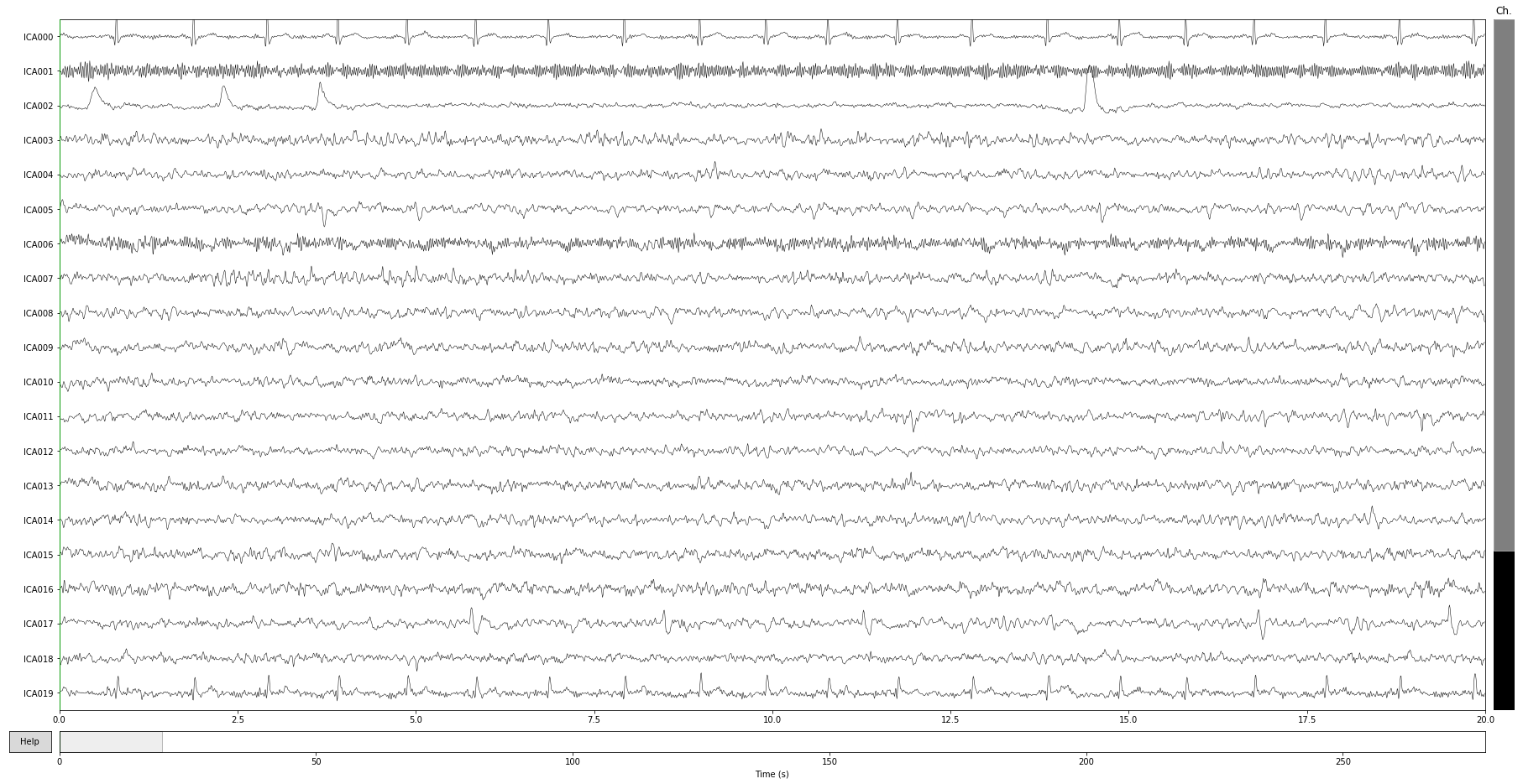
Component properties
Let’s take a closer look at properties of first three independent components.
# first, component 0:
ica.plot_properties(raw, picks=0)
Rejecting epoch based on MAG : ['MEG 1711']
Artifact detected in [12642, 12943]
Rejecting epoch based on MAG : ['MEG 1711']
Artifact detected in [17458, 17759]
Creating RawArray with float64 data, n_channels=376, n_times=40936
Current compensation grade : 0
Range : 0 ... 40935 = 0.000 ... 272.621 secs
Ready.
Using multitaper spectrum estimation with 7 DPSS windows
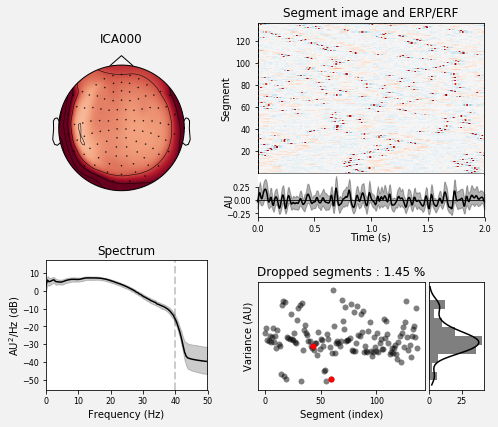
[<Figure size 504x432 with 6 Axes>]
Advanced artifact detection
Let’s use a more efficient way to find artifacts
from mne.preprocessing import create_eog_epochs
eog_average = create_eog_epochs(raw, reject=dict(mag=5e-12, grad=4000e-13),
picks=picks_meg).average()
EOG channel index for this subject is: [375]
Filtering the data to remove DC offset to help distinguish blinks from saccades
Setting up band-pass filter from 2 - 45 Hz
Filter length of 2048 samples (13.639 sec) selected
Setting up band-pass filter from 1 - 10 Hz
Filter length of 2048 samples (13.639 sec) selected
Now detecting blinks and generating corresponding events
Number of EOG events detected : 46
46 matching events found
No baseline correction applied
Not setting metadata
Created an SSP operator (subspace dimension = 3)
Loading data for 46 events and 151 original time points ...
0 bad epochs dropped
eog_epochs = create_eog_epochs(raw, reject=reject) # get single EOG trials
eog_inds, scores = ica.find_bads_eog(eog_epochs) # find via correlation
ica.plot_scores(scores, exclude=eog_inds); # look at r scores of components
EOG channel index for this subject is: [375]
Filtering the data to remove DC offset to help distinguish blinks from saccades
Setting up band-pass filter from 2 - 45 Hz
Filter length of 2048 samples (13.639 sec) selected
Setting up band-pass filter from 1 - 10 Hz
Filter length of 2048 samples (13.639 sec) selected
Now detecting blinks and generating corresponding events
Number of EOG events detected : 46
46 matching events found
No baseline correction applied
Not setting metadata
Created an SSP operator (subspace dimension = 4)
Loading data for 46 events and 151 original time points ...
0 bad epochs dropped
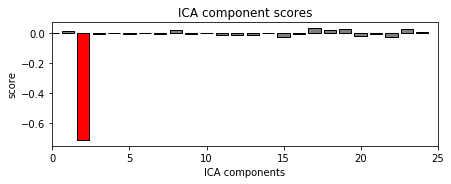
we can see that only one component is highly correlated and that this component got detected by our correlation analysis (red).
ica.plot_sources(eog_average, exclude=eog_inds); # look at source time course

We can take a look at the properties of that component, now using the data epoched with respect to EOG events. We will also use a little bit of smoothing along the trials axis in the epochs image:
ica.plot_properties(eog_epochs, picks=eog_inds, psd_args={'fmax': 35.},
image_args={'sigma': 1.})
Using multitaper spectrum estimation with 7 DPSS windows
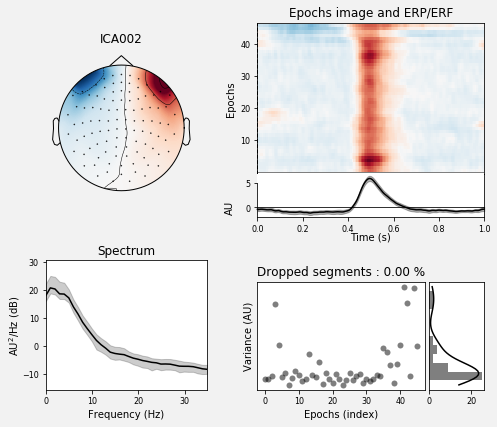
[<Figure size 504x432 with 6 Axes>]
Now let’s see how we would modify our signals if we removed this component from the data.
ica.plot_overlay(eog_average, exclude=eog_inds, show=False)
# red -> before, black -> after. Yes! We remove quite a lot!
# to definitely register this component as a bad one to be removed
# there is the ``ica.exclude`` attribute, a simple Python list
ica.exclude.extend(eog_inds)
Transforming to ICA space (25 components)
Zeroing out 1 ICA components
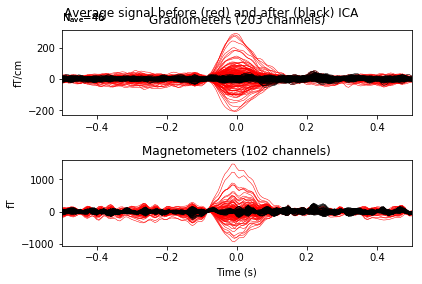
from now on the ICA will reject this component even if no exclude parameter is passed, and this information will be stored to disk on saving
# uncomment this for reading and writing
# ica.save('my-ica.fif')
# ica = read_ica('my-ica.fif')
Note that nothing is yet removed from the raw data. To remove the effects of
the rejected components, mne.preprocessing.ICA.apply must be called.
Here we apply it on the copy of the first ten seconds, so that the rest of
this tutorial still works as intended.
raw_copy = raw.copy().crop(0, 10)
ica.apply(raw_copy)
raw_copy.plot(); # check the result
Transforming to ICA space (25 components)
Zeroing out 1 ICA components
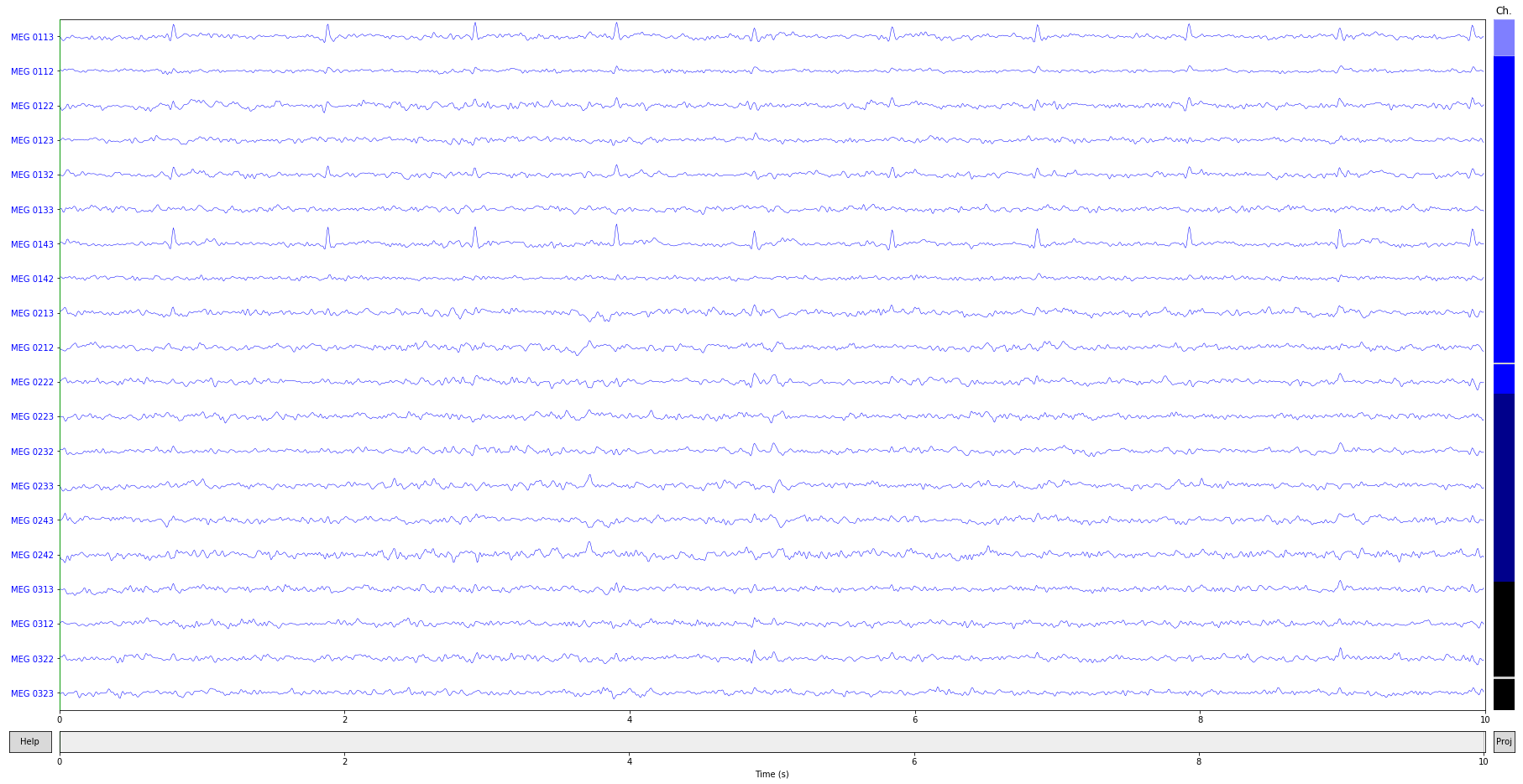
Exercise
Find and remove ECG artifacts using ICA!
from mne.preprocessing import create_ecg_epochs